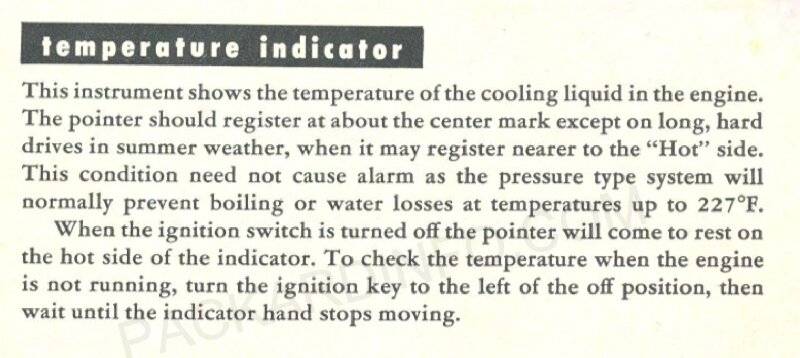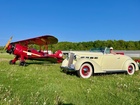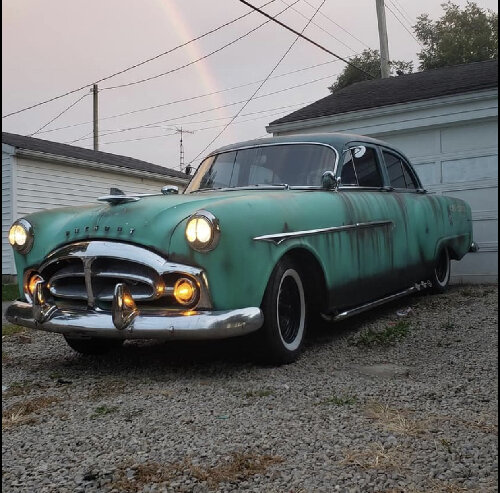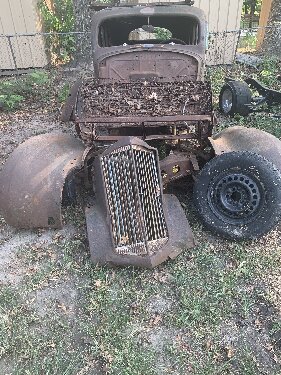|
Re: 327 Engine Operating Temp Range
|
||||
|---|---|---|---|---|
|
Forum Ambassador
|
Based on the description I would say your car is doing about as well as designed. Depending on the thermostat you have installed, it would get at least to that point before it opened and any cooling was even started. An extra 10-15 degrees more with a normal full air flow would be in a good working range.
Here is a bit from a 23rd series owners manual.
Posted on: 2023/4/12 12:10
|
|||
|
Howard
|
||||
|
||||
|
Re: 327 Engine Operating Temp Range
|
||||
|---|---|---|---|---|
|
Home away from home

|
That all sounds normal to me. Mine is running about the same temps as yours in most situations. My gauge reads slightly higher than yours does, but engine temps with a gun are right about 170-180 in normal driving. It will creep up to 195-200 on a hot day sitting.
My understanding is that these engines have a pretty wide range of heat tolerance. In the '54 owners manual it says "the pressure type system will prevent boiling or fluid losses at temperatures up to 248 degrees". If there is no coolant boiling over then things should be fine. I monitor my temperature quite a bit because I'm slightly paranoid, but I think I worry too much. It sounds like your car is running very much like mine, which I believe is fine. -Kevin
Posted on: 2023/4/12 12:11
|
|||
|
||||
|
Re: 327 Engine Operating Temp Range
|
||||
|---|---|---|---|---|
|
Home away from home
|
With modern oil and anti-freeze and a pressurized system, you're fine up to 200-210F. The coolant will be hottest at the cylinder head outlet. Depending on how much presssure your system holds, and how far above sea level you are, your car should not boil over at 230F or less, unless there are hot spots in the engine from a bad water distribution tube or too much debris accumulation. It seems to be normal for most cars to run hotter in hot weather and a little cooler in cool weather, in spite of thermostats. Engines need to run at 180 to 185 F minimum. Cold running engines develop excess carbon and sludge, and can even collect water in the oil pan and develop rust in the internal spaces of the engine. Poor gas mileage is another issue with a cold-running engine. It's important that the fan belt be in good condition and tightened correctly, and that the water pump be in good condition and not leak coolant out or air in. A worn water pump can leak air into the cooling system at higher speeds, and this will cause serious problems, including corrosion, steam pockets, coolant aeration, and boilover Such a pump will usually, but not always, leak coolant out when sitting.
A pump with worn bearings will usually leak, and bearing failure can send the fan into the radiator.
Posted on: 2023/4/14 13:28
|
|||
|
||||
|
Re: 327 Engine Operating Temp Range
|
||||
|---|---|---|---|---|
|
Home away from home
|
Usually water pumps fail because the seals start leaking and then coolant gets into the bearings. This will be evident by coolant leaking out of the small weep or drain hole in the pump. Pump bearings can easily be checked by removing the belt and spinning the pump. It should be smooth and quiet.
Posted on: 2023/4/14 14:36
|
|||
|
We move toward
And make happen What occupies our mind... (W. Scherer) |
||||
|
||||
|
Re: 327 Engine Operating Temp Range
|
||||
|---|---|---|---|---|
|
Home away from home
|
I don’t know if it would help you or not, or even if they would fit a 22nd or 23rd series Packard but I have several of the larger 20” fans as used on ‘53 and ‘54 with factory A/C. These look just like the stock fan but are larger for better air flow.
Posted on: 2023/4/15 2:58
|
|||
|
||||
|
Re: 327 Engine Operating Temp Range
|
||||
|---|---|---|---|---|
|
Home away from home
|
A bigger fan will help cooling at idle and low speeds. The penalty is usually more noise and more power consumed by the fan. A clutch fan avoids the penalty by regulating the fan as needed. Late timing, whether from an incorrect initial setting or due to improper and out-of-spec distributor operation, will cause excess temperature rise, especially at idle and low speeds. Wear in the mechanical parts, including timing chain, etc, may be such that an initial timing setting 2 to 5 degrees or so earlier than stock may be helpful. Most old distributors need the advance mechanisms repaired and adjusted to work properly and give best performance and mileage and prevent overheating and other issues related to erratic timing or an off-spec timing curve.
The fan has little to no effect at road speeds over about 30 MPH. A low temperature thermostat won't cure issues related to late timing or debris in the cooling system or a water pump issue. It will allow an engine to run too cold under some conditions if the cooling system is in good condition. Running cold is hard on the engine and fuel economy, and it will reduce the effectiveness of the heater and defrost systems. I'd run at least a 180F thermostat, and in cold weather country I'd consider a 190 or 195 F thermostat. A properly serviced distributor can really wake up and engine, and can contribute to cooler operation and better fuel economy and less tendency to flood after a hot shut down.
Posted on: 2023/4/15 10:09
|
|||
|
||||
|
Re: 327 Engine Operating Temp Range
|
||||
|---|---|---|---|---|
|
Forum Ambassador
|
A question on the heavy duty post 51 327 engine fans mounting to the pre 51 327 engine would be hub size and center hole bore on the fans. They did offer a heavy duty fan for the earlier engines so they are available but no idea what if anything might have changed in the later fan mounting.
While the blocks are essentially the same the pump castings are different and I don't know if the 327 hub sizes changed with the pumps and years. Do know the 356 fan uses a much larger hub and bore so the later heavy duty fans would not fit on those engines. With the pre 51 radiators being taller and narrower than the later radiators fan diameter may have changed after 51 and there could also be clearance issues.
Posted on: 2023/4/15 10:32
|
|||
|
Howard
|
||||
|
||||
|
Re: 327 Engine Operating Temp Range
|
||||
|---|---|---|---|---|
|
Home away from home
|
You can fit a modern flex fan on these engines. It will require some spacers to get the new fan mounted beyond the end of the large pump shaft. Then you get into the discussion about hub centric vs. bolt centric. Will there be runout problems if the fan is not being centered on the shaft? I have mounted these new fans on Packard engines without any misalignment problems. Smooth and true.
Posted on: 2023/4/16 12:41
|
|||
|
We move toward
And make happen What occupies our mind... (W. Scherer) |
||||
|
||||
|
Re: 327 Engine Operating Temp Range
|
||||
|---|---|---|---|---|
|
Home away from home
|
I had one on my 1954 for many years but recently removed it and put on a 20” stock fan instead. The flex fan was not only very noisy but it appears to also touch the radiator now and then as the marks from it are there! They flex in more ways that just the pitch of the blades.
Posted on: 2023/4/16 13:30
|
|||
|
||||

 temp.jpg (101.26 KB)
temp.jpg (101.26 KB)







